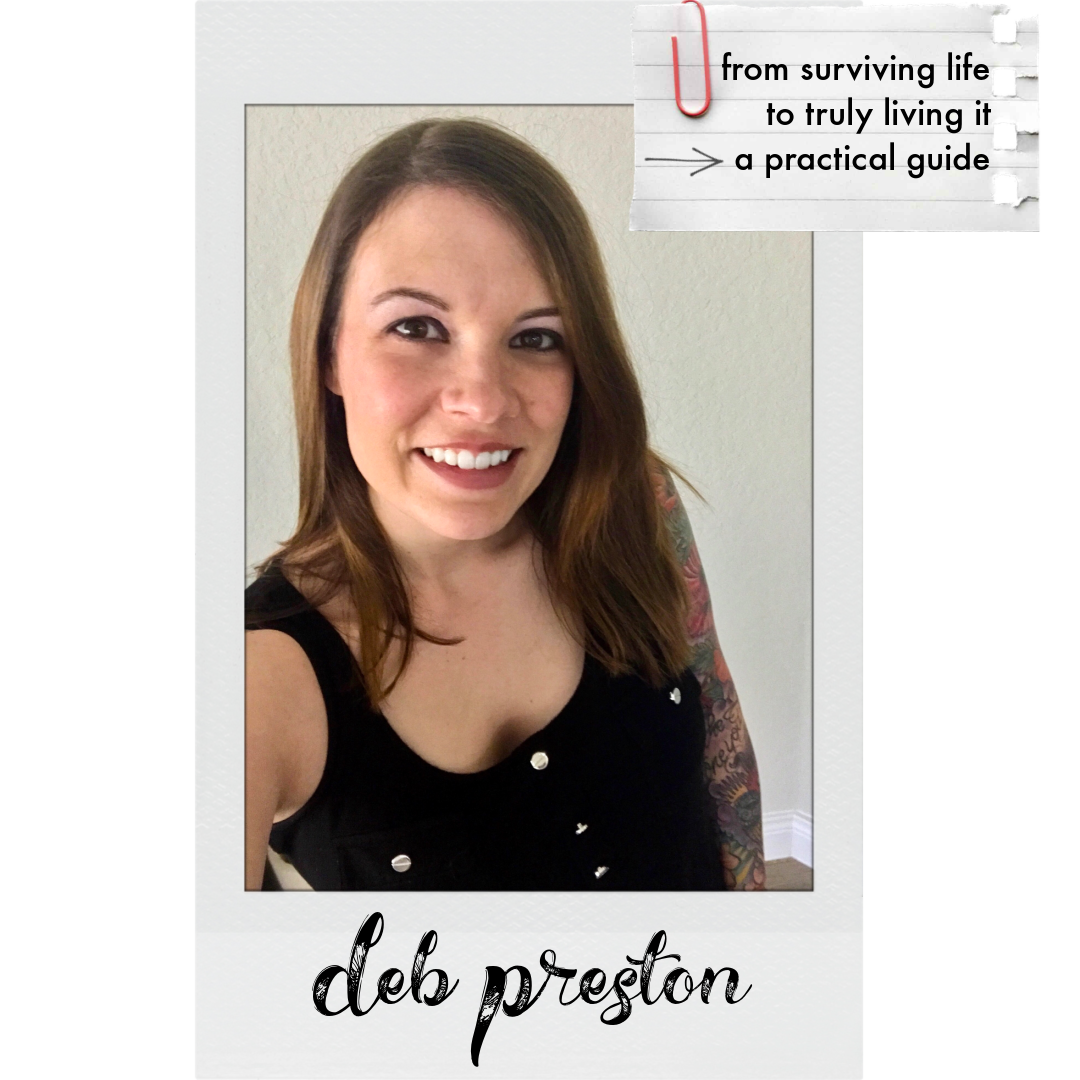Oooof, four is a tough age for buying bikes! My daughter wanted to zoom away into the sunset at that age and yet, had the grace and balance of a panda.
Should we get her a small bike with training wheels? Or maybe a balance bike?
Could she figure out rear brakes? Did she have the coordination for hand brakes? And exactly how many Band-Aids would we need to buy?!
Luckily for you, our family mastered the best bikes for 4 year olds and compiled all the options into one place, so all you have to do…is read the summary! Boom!
What are the best bikes for 4 year olds? Let’s talk about it!
1. Choosing the Best Bike Style for Your 4 Year Old
Four-year-olds need bikes that match both their physical abilities and their confidence levels. If you have kids this size, then you’ll understand these two factors don’t always match up.
It’s important to consider where your 4-year-old lands in both of these areas to help you determine the best choice for your child’s first bike.
Balance Bikes vs Training Wheels
First decision: Do you want a balance bike or a pedal bike with training wheels?
Balance bikes work well for kids who haven’t mastered balance yet. These bikes have no pedals, so children push with their feet while learning to steer and balance.
Balance bikes help with:
- Building confidence slowly
- Learning balance naturally
- Easy stopping with feet
- Lighter weight for small children
Training wheels offer a different approach for your child’s first bike experience. They provide stability while kids learn to pedal and steer at the same time.
Training wheels are good for:
- Children who want to pedal into the sunset right away
- Kids who feel scared on balance bikes
- Learning pedaling and braking together
Many experts suggest balance bikes first because they teach the hardest skill – balancing. Once kids can master balance, pedaling becomes much easier to learn.
First Pedal Bicycles
Decided to take the pedal bike route?
A classic “first pedal bike” works best for children who already have some balance and coordination, or those who have successfully used a balance bike. These bikes typically come in 12-inch or 14-inch wheel sizes for four-year-olds.
Key features to look for:
- Adjustable seat height for growing kids
- Hand brakes that small hands can reach
- Lightweight frame for easy handling
- Chain guard to protect clothes and legs
Seat height matters most when choosing your child’s first bike.
Your child should be able to touch the ground with both feet when sitting on the bike. The right fit will help your child feel confident and safe while learning to ride.
BMX and Mountain Style Options
BMX-style bikes appeal to kids who want a sportier, some may say “cooler,” look. (Ask us how we know.) They’re less likely to offer training wheel options, making them great for kids with a “just do it” attitude who have no interest in slow build-ups.
These bikes have smaller frames, knobby tires, and often come in the bright colors four-year-olds love.
BMX features include:
- Sturdy construction for active play
- Single-speed design that’s simple to use
- Lower seat position for better control
Mountain bike styles offer a different adventure feel for young riders. These bikes usually boast wider tires and upright riding positions, perfect for neighborhood park trails.
Mountain bike style benefits include:
- Better stability on different surfaces
- Comfortable riding position
- Durable parts that handle rough play
Both styles work well as kids bikes, but BMX models tend to be lighter. While mountain bike styles are heavier, they also offer more comfort for longer rides around the neighborhood.
The best choice for your child will depend on where they’ll ride most often. BMX styles work well on smooth sidewalks, while mountain bike designs are better suited for rougher terrains.
2. Choosing the Best Bike for Your 4 Year Old
There are several trusted brands out there making quality bikes for young riders. There are also a few off-brand quality bikes that are racking up a surprising number of 5-star reviews!
Reputable Kids’ Bike Brands
Strider leads the balance bike market and makes fantastic first bikes for 4-year-olds. Their bikes help kids master balance before pedaling.
Guardian Bikes creates bikes with unique safety features. They offer a patented braking system that stops both wheels at the same time!
Woom designs lightweight bikes specifically for children. Their bikes weigh much less than big box brands, making them easier for kids to handle.
Trek and Mongoose offer quality kids’ bikes from companies that also make adult bikes. These brands use better parts than the cheaper options.
Raleigh focuses on proper sizing and geometry for children. Expert recommendations often include this brand for its attention to detail.
REI Co-op bikes cost less than more premium brands but still offer solid construction.
Highly-Rated Kids’ Bikes
But maybe you’re one of those people who doesn’t like to narrow a purchase down to a brand. You want to know what the people say about alllll of your options, am I right?
Well, my friend, these are the top kids’ bikes according to the king of customer reviews, Amazon:
JOYSTAR Kids Bike

This bike delivers solid value for parents wanting a reliable first bike that their 4-year-old can learn and grow with.
Pros
- Training wheels provide excellent stability while kids build confidence
- Quick-release seat makes height adjustments super easy as your child grows
- Steel frame withstands crashes and rough play without breaking
Cons
- Some packages arrive missing the bell or small accessories
- Bike might feel small after just one year of use
- Assembly can be tricky even though most parts come pre-built
Schwinn Elm and Koen Kids Bike
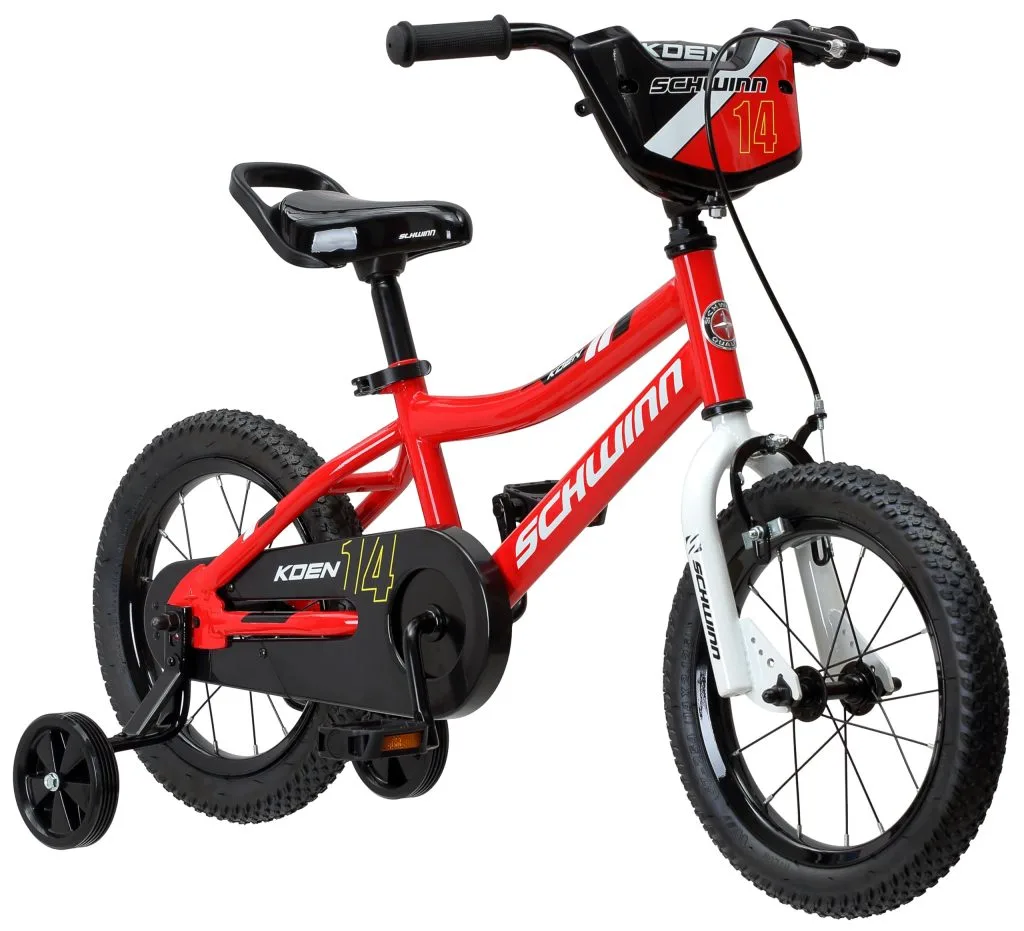
This bike offers solid construction and grows with your child, making it a smart choice for parents who want a bike that lasts through multiple years.
Pros
- Tool-free seat adjustment lets you change the height as your child grows
- Sturdy build quality holds up well to rough play and daily use
- Simple assembly takes about 30 minutes with basic tools
Cons
- Seat comfort could be better for longer rides
- Some parts may arrive loose and need tightening
- Brake adjustments might require fine-tuning after assembly
RoyalBaby Freestyle Bike
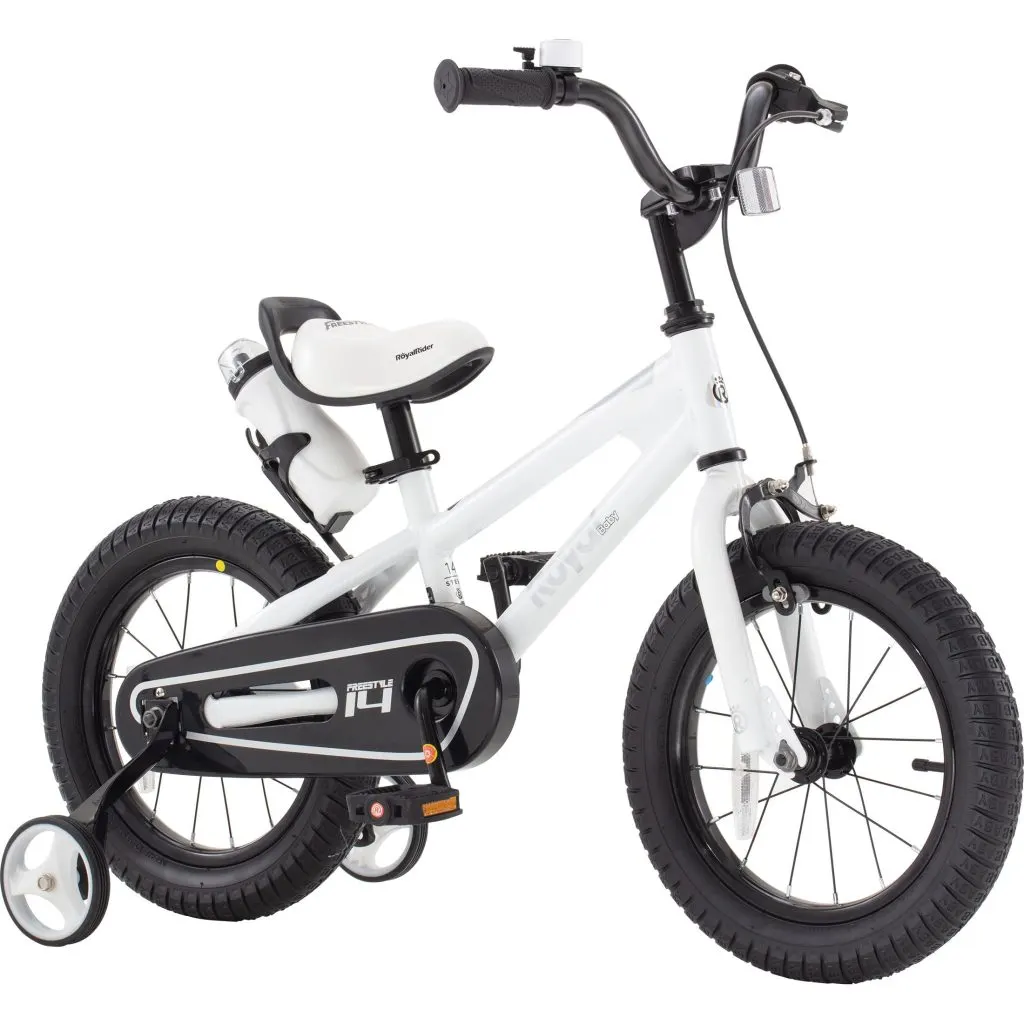
This BMX-style bike offers great value with solid safety features, though your child might outgrow it faster than expected.
Pros
- Training wheels and adjustable parts make learning to ride much easier
- Wide tires and strong brakes give parents peace of mind about safety
- Assembly takes only 20 minutes with clear instructions and included tools
Cons
- This bike feels heavier than other models when kids try to move it around
- Some parts like the water bottle holder seem cheaply made
- Size options are limited so your child may need an upgrade sooner
JOYSTAR Pluto Kids Bike
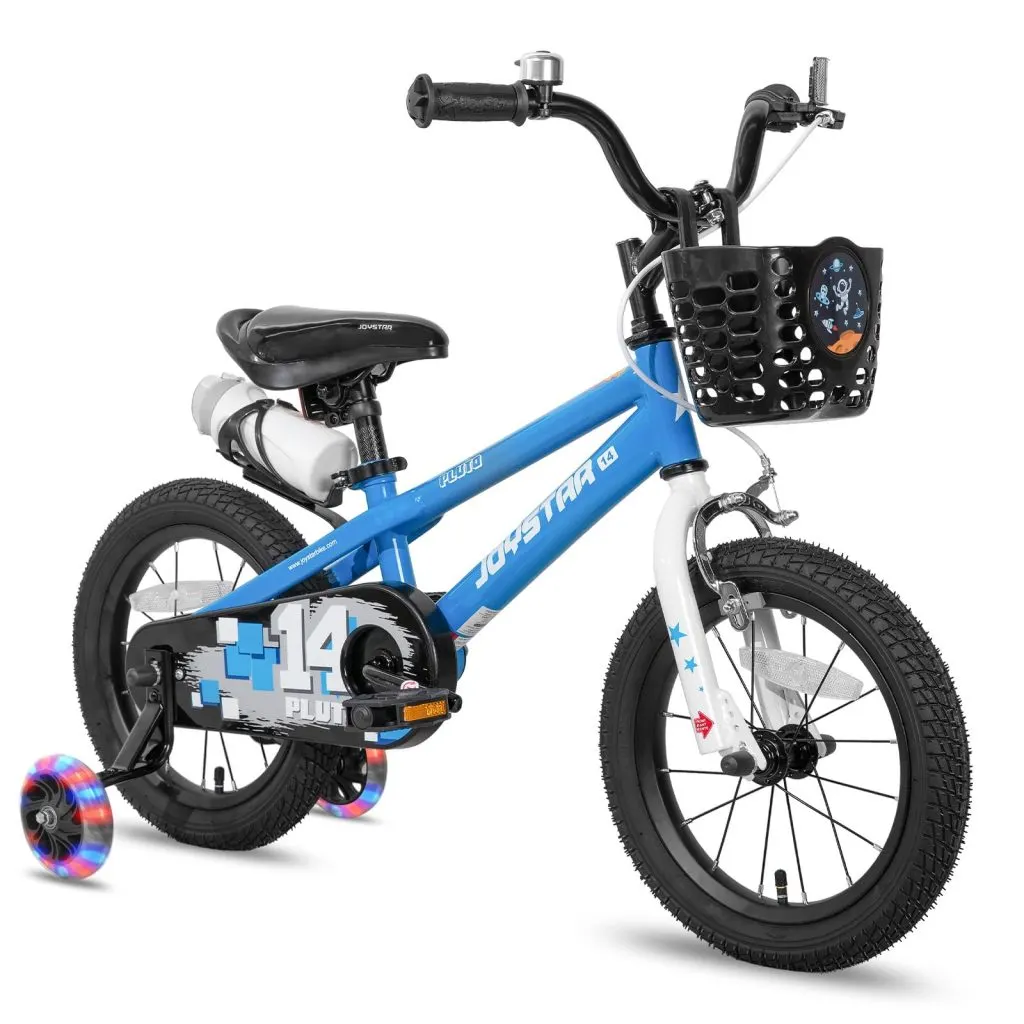
This bike offers great value with its fun light-up training wheels and complete accessory package, though the weight might challenge smaller riders.
Pros
- Training wheels light up and create excitement for new riders
- Comes with everything needed including a basket, bell, and water bottle
- Quick seat adjustment makes growing with your child simple
Cons
- Heavier than expected for a 12-inch bike
- Assembly can be tricky especially with brake adjustments
- Some bikes arrive with scratches or missing small parts
WEIZE Pink/Pastel Bikes
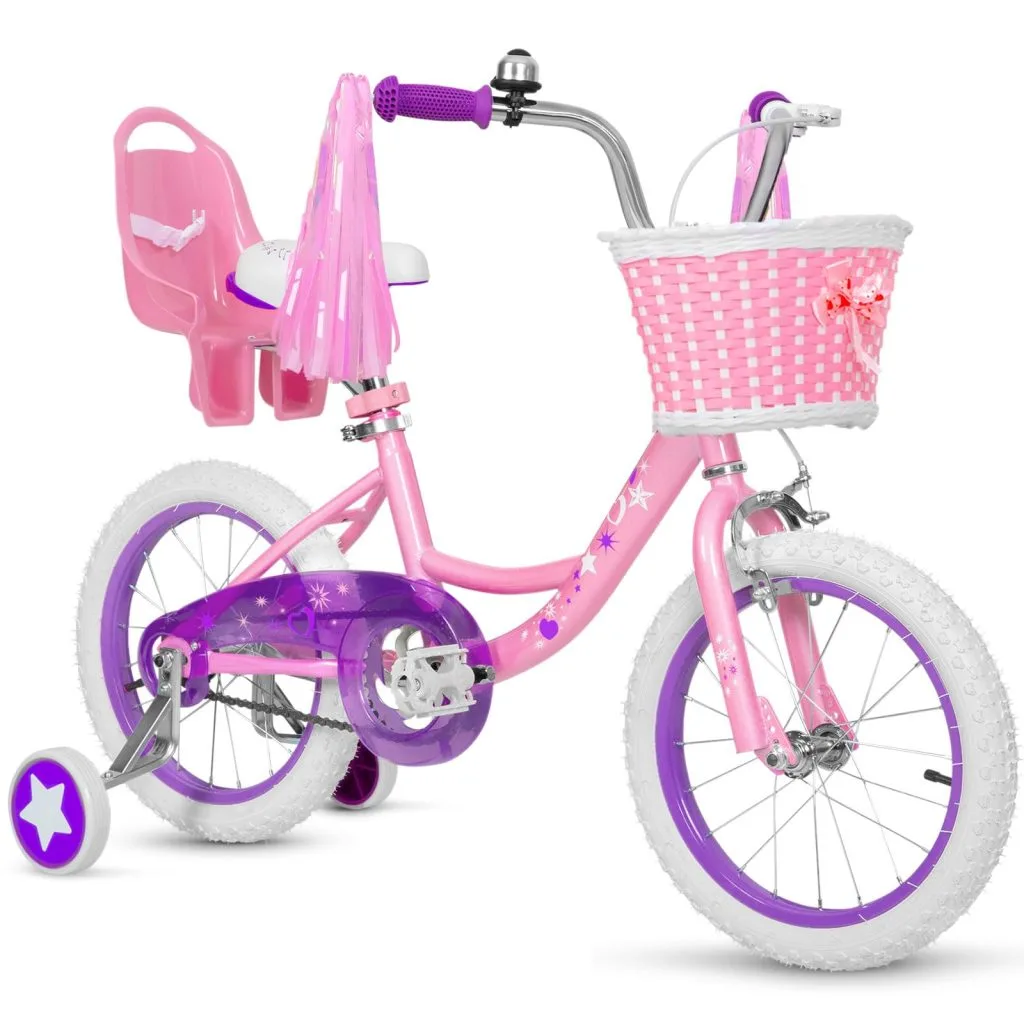
This adorable pink bike gives your kiddo everything they need to start riding with confidence and style.
Pros
- Comes with fun extras like streamers, basket, and doll seat that keep kids excited about riding
- Assembly takes just 20 minutes with clear instructions and helpful video guide
- Training wheels provide solid stability while your child learns to balance
Cons
- At 19 pounds, it feels heavier than some other bikes in this size range
- Hand brake can be tough for smaller kids to squeeze with enough force
- Chain guard placement makes pedaling feel slightly restricted at first
WEIZE Blue/Black Bikes
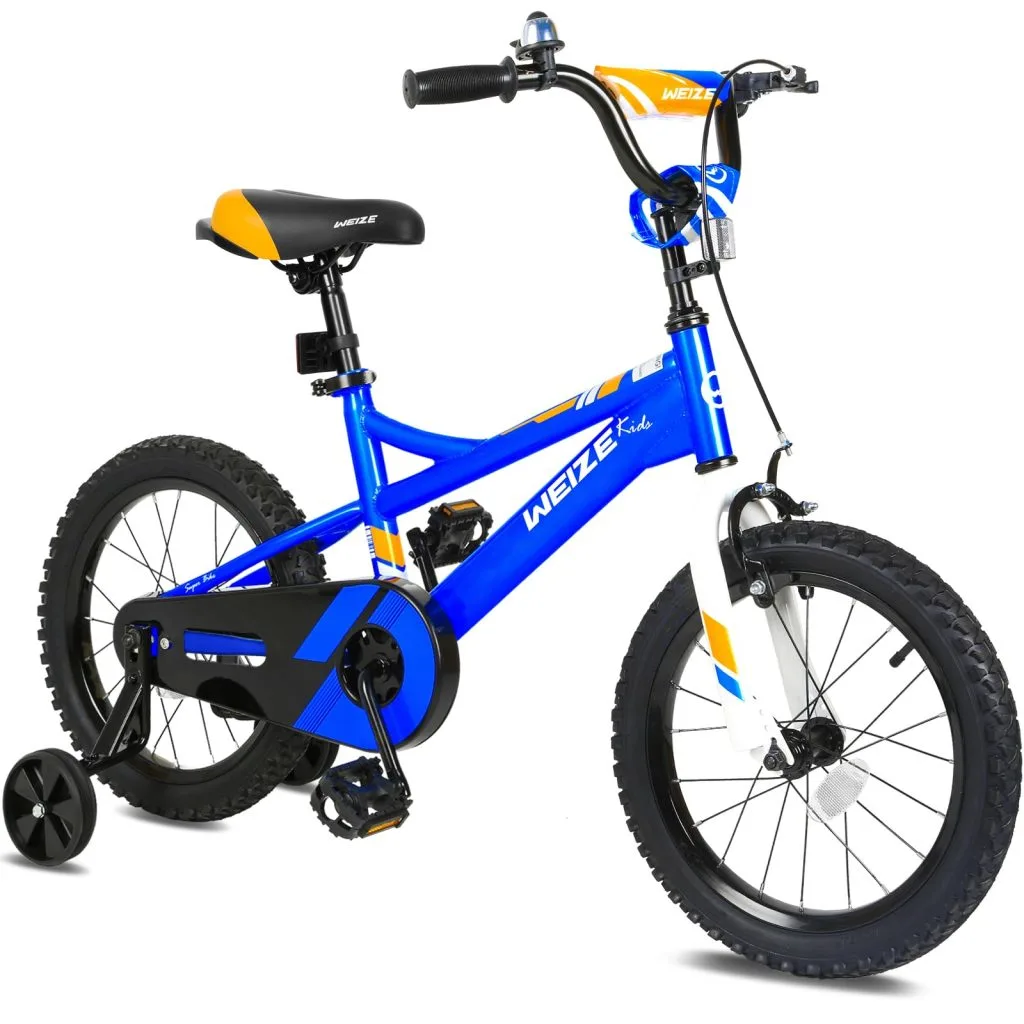
This bike offers solid value for beginners with its lightweight frame and safety features, though you’ll need to check sizing carefully.
Pros
- Training wheels come off easily when your child gains confidence
- Chain guard keeps little fingers and clothes safe during rides
- Assembly takes less than an hour with clear instructions
Cons
- Seat padding feels thin after longer rides
- Hand brakes require more strength than some kids can manage
- Frame size runs small compared to other 16-inch bikes
ONLYGU Kids Bike
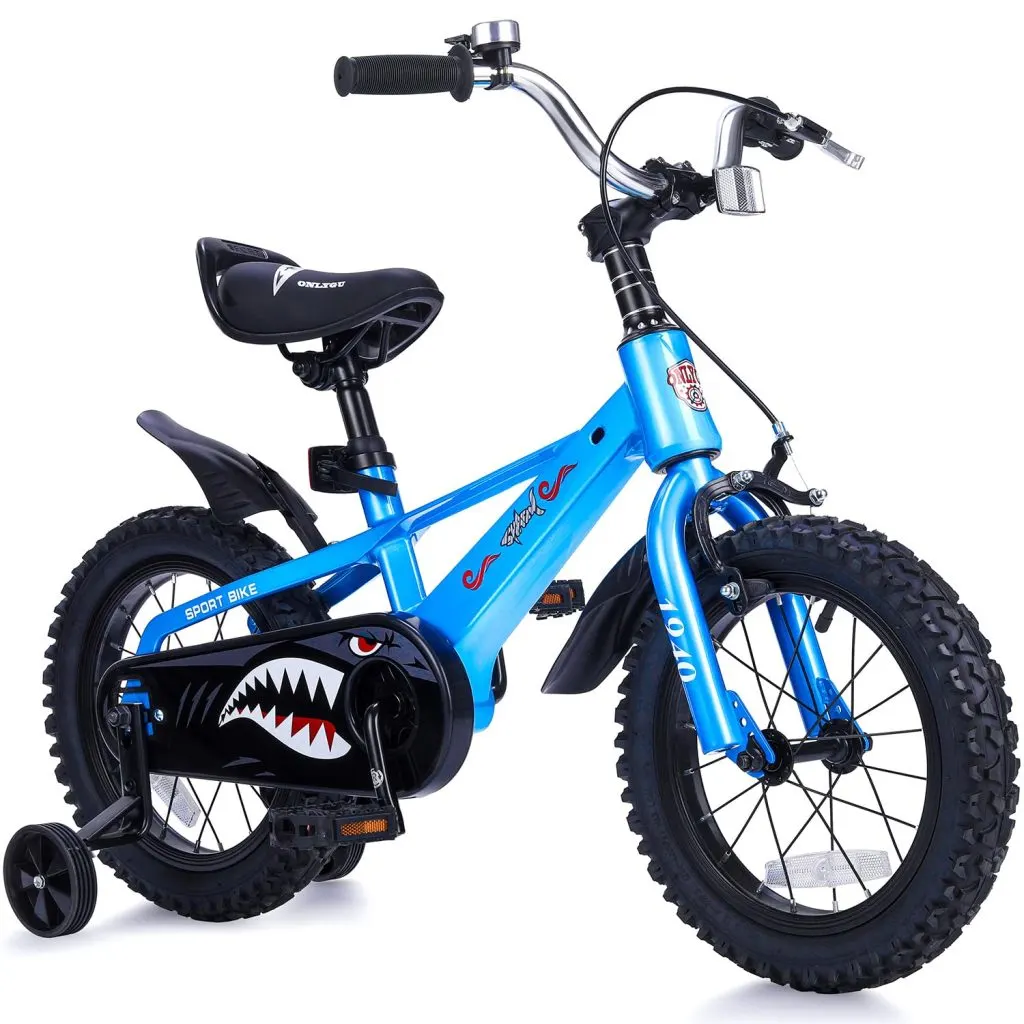
This bike works well for most 4-year-olds who are just starting to ride, though some parts may need extra attention.
Pros
- Assembly goes quickly since most parts come already put together
- Training wheels provide good balance for new riders learning bike skills
- Seat and handlebars adjust easily as your child gets taller
Cons
- Some smaller parts, like the bell, can feel cheap and break easily
- A few pieces might come loose after regular use
- Package sometimes arrives with damaged boxes
KRIDDO Toddler Tricycle
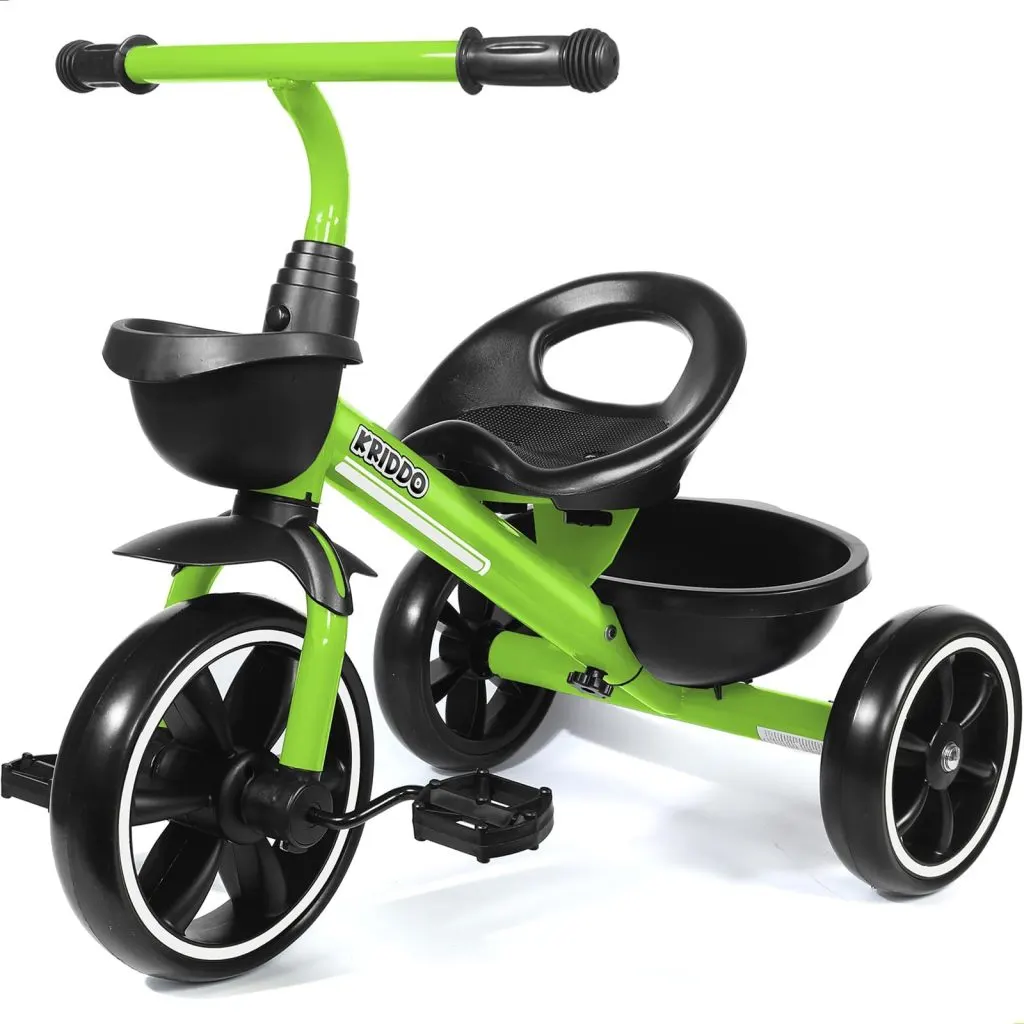
Not quiiiiite ready for two wheels yet? No worries at all!
This tricycle offers great stability and build quality that makes it a smart choice for smaller 4 year olds learning to ride.
Pros
- Wide wheelbase design prevents tipping during rides
- Silent wheels work perfectly on indoor floors without scratches
- Lightweight frame makes it simple to move around the house
Cons
- Assembly requires some time even though instructions are clear
- Size works best for smaller kids and may outgrow quickly
- Handle grips could be slightly thicker for better comfort
JOYSTAR Macaroon Girls Bike
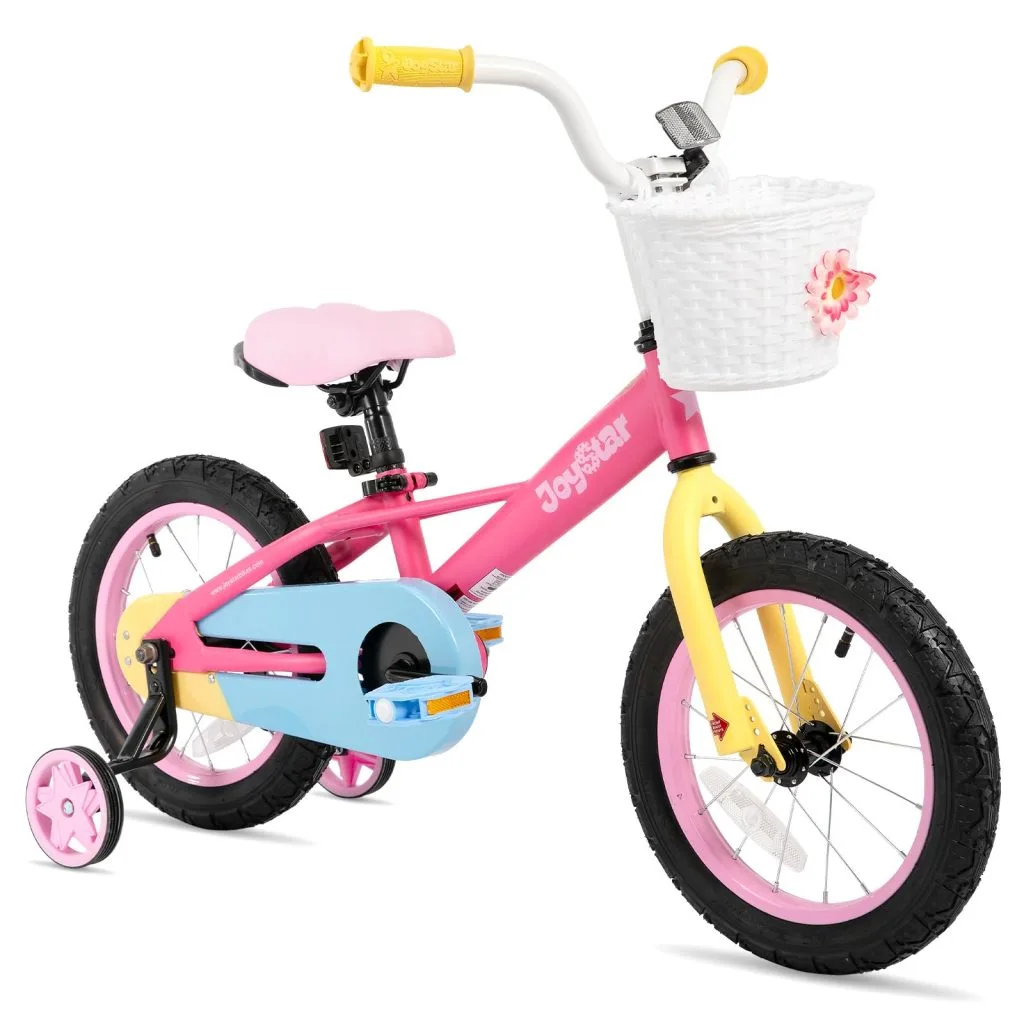
This colorful starter bike delivers solid performance for young riders who need training wheels and want eye-catching style.
Pros
- Bright macaroon colors and fun accessories like the basket make kids excited to ride
- Sturdy steel frame handles bumps and falls during the learning process
- Coaster brakes are simple for small hands to operate safely
Cons
- Training wheels may come loose and need frequent tightening
- The bike feels heavy compared to other models in this size range
- Assembly takes time even though it comes mostly put together
JOYSTAR Angel Girls Bike
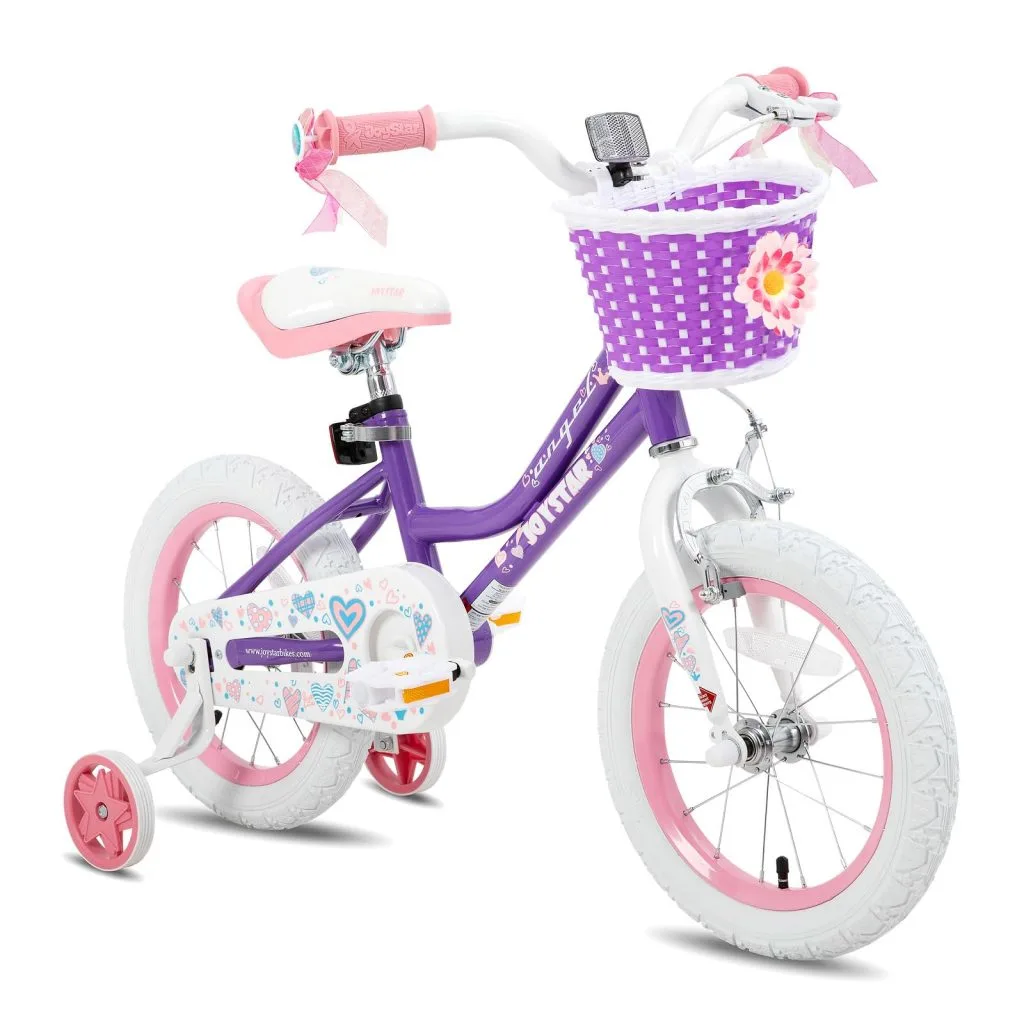
This pretty purple bike offers great value for young kids learning to ride, though you might need to adjust the brakes after assembly.
Pros
- Beautiful design with basket and colorful details that kids absolutely love
- Easy assembly with clear instructions and all tools included
- Sturdy steel frame handles bumps and crashes during learning
Cons
- Brakes often need adjustment and can be squeaky right out of the box
- Some parts like the bell might be missing from your shipment
- Hand brake alignment can be tricky to get just right
Comparing Your Local Bike Shop with Big-Box Stores
Local bike shops will offer expert help when choosing your child’s first bike. Staff can properly fit the bike to your child and make adjustments.
These shops also offer better assembly and tune-up services. They’ll check every part before your child rides the bike home.
Big-box stores like Walmart and Target sell cheaper and, sometimes, more exciting bikes (think: popular trend and TV character themes). However, these bikes often weigh more and use lower-quality parts than specialty brands.
Assembly quality also varies at big-box stores. Many parents need to take big box brands to a local bike shop for proper setup after purchase.
Online retailers like Amazon offer convenience and competitive prices. They allow you to read reviews and compare models easily from home.
The downside is that you can’t test the bike before buying. Your child will also miss out on the opportunity to sit on different models to find the best fit.
Specialty online retailers focus only on kids’ bikes. These companies often provide better quality than general retailers and offer detailed sizing guides.
2a. Perfecting Size and Fit For Your Child’s First Bike
Contrary to our kids’ (very strong) beliefs, choosing the best bike for 4 year olds is about more than the colors and fun features of the bike!
Getting the right bike means looking at wheel diameter and how your child fits on the frame, as well as making sure they can reach the handlebars and pedals comfortably. You want to make sure your 4 year old doesn’t just look cool on their new bike, but also feels confident and safe.
Wheel Size for 4 Year Olds
Most 4-year-olds need bikes with 12 to 14-inch wheels, but the exact wheel size depends on your child’s height. Their height is actually more important than their age when you’re deciding on wheel diameter.
Here’s what works best for different heights:
| Child’s Height | Recommended Wheel Size |
|---|---|
| 37-44 inches | 12-inch bike |
| 44-50 inches | 14-inch bike |
Some taller 4-year-olds might be ready for 16-inch wheels. This happens when they’re closer to 50 inches tall.
Body weight also matters when choosing wheel size. Heavier kids can often handle bigger wheels better, while more petite kids tend to do better with smaller wheels that are easier to control.
Choosing the right wheel size will help your child start and stop more safely. It also makes turning and steering much easier for little riders.
Frame and Body Fit
The right bike frame will allow your child to sit comfortably with both feet touching the ground. This is the most important safety rule when buying any bike.
Your child should be able to straddle the bike with both feet flat on the ground. There should be 1-2 inches of space between your child and the top tube when standing.
When sitting on the seat, your child’s feet should reach the ground easily. You’ll want to make sure their knees still have a slight bend when the pedal is at its lowest point.
It’s also important to check that your child can reach the brakes comfortably! Their small hands need to be able to grip and squeeze the brake levers without stretching.
The right size bike will feel stable and secure to your child. They shouldn’t feel like they’re stretching or cramped when riding.
Never buy a bike that’s too big. The idea of “growing into it” creates safety risks, since young children need full control of their bike from day one.
Adjusting Handlebar and Seat Height
Proper handlebar adjustment will also help your child ride comfortably and safely.
Your child should be able to reach the handlebars with a slight bend in their elbows. Their back should stay straight, not hunched over or stretched out.
Start with the seat low enough that your child’s feet touch the ground completely. As they get more confident, you can raise the seat slightly.
The seat height is right when your child’s leg has a small bend at the knee when the pedal is down. This gives them good pedaling power without straining.
Most bikes have quick-release clamps that make adjusting seat and handlebar height super easy. You’ll want to check these settings every few months as your child grows.
2b. Key Features to Look For in Your Child’s First Bike
The right bike features will make learning safer and more enjoyable for your 4-year-old. Lightweight frames improve easy handling, while proper braking systems will give you (and them!) peace of mind during those first rides.
Lightweight Frames
Weight matters more than you might think when choosing your child’s bike.
Steel frame bikes are durable but often too heavy for 4-year-olds. They can weigh 15-20 pounds, which can make pedaling and maneuvering more challenging for little legs.
Lightweight aluminum frame bikes are your best choice. They typically weigh 8-12 pounds, making them much easier for children to control and lift.
A good rule of thumb is to look for bikes that weigh less than half your child’s body weight.
That means that a 40-pound child should ride a bike under 20 pounds to ensure comfortable handling.
The frame design also affects weight distribution. Lower frames will help your child touch the ground with both feet while seated, building confidence and making stops safer.
Some premium bikes use carbon fiber, but these are usually unnecessary for 4-year-olds. Aluminum offers the perfect balance of light weight and affordability for this age group.
Braking Systems Explained
Your 4-year-old needs brakes they can actually use when needed. Different brake types work better for different skill levels.
Coaster brakes work by pedaling backward.
They’re easier for beginners because kids naturally pedal backward when they want to stop. These brakes are built into the rear wheel hub.
Hand brakes require more coordination but offer better control.
But you’ll want to look for small brake levers designed for tiny hands. Your child should be able to squeeze them easily while maintaining their grip on the handlebars.
Some high-end models feature hydraulic disc brakes, but honestly? These are overkill for this age group. Simple rim brakes or coaster brakes will get the job done while requiring less maintenance.
Test the brake lever reach before buying any bike. Your child should be able to comfortably reach and squeeze the brakes without stretching their fingers or loosening their steering grip.
Suspension and Tires
Most 4-year-olds don’t need complex suspension systems, but your tire choice will significantly affect your child’s comfort and safety.
Suspension forks, while a possibility for your child’s first bike, add weight and complexity without much benefit for neighborhood riding. Since they’re designed for rougher terrain that most 4-year-olds won’t encounter, it’s usually best to skip the suspension and focus on lighter bikes instead.
Tire width impacts stability a lot more than suspension.
Wider tires (1.5-2 inches) will provide better balance and grip on a variety of surfaces. They also offer some natural shock absorption.
Knobby tires work well for mixed riding surfaces like grass, dirt paths, and pavement. Smooth tires roll faster on pavement but will slip more on loose surfaces.
It’s important to choose tires based on where your child will ride most often. Neighborhood streets and bike paths work fine with smoother treads, while parks and trails will require more aggressive patterns.
And it doesn’t stop there! Proper tire pressure will keep rides smooth and prevent flats. Plus, under-inflated tires will make pedaling a lot harder.
That’s why you’ll want to check that your child’s tires are inflated to the recommended pressure printed on the sidewall.
3. Safety Considerations for Young Riders
Getting the right protective gear makes the difference between potential accidents and a great bike experience. Plus, creating a safe riding environment will help young children build confidence while learning!
Essential Safety Gear
Safety gear for every ride should include:
- CPSC-approved helmet
- Knee and elbow pads for beginners
- Closed-toe shoes with good grip
- Long pants to help protect legs
- Bright colored clothing for visibility
A properly fitted helmet will protect your child’s head during inevitable falls. The helmet should sit level on their head, not tilted back or forward.
Check that the helmet chin strap forms a “V” under each ear. You should only be able to fit one finger, max, between the strap and their chin.
Be sure to replace helmets after any crashes, even if you can’t see any damage, since the foam inside may have compressed and lost its protective ability.
You might also consider knee and elbow pads for beginners. These provide some extra protection during the learning phase, when falls happen more often and could more easily discourage little riders.
Supervision and Riding Environment
No matter how confident or independent they are, young children need constant adult supervision while riding. In fact, it’s a good idea to stay within arm’s reach during their first few rides.
Choose safe locations, like your city park’s paved paths or empty parking lots, for learning and riding. Avoid nighttime rides, sidewalks along busy streets, or areas with poor visibility.
Ideal practice locations:
- Smooth, flat surfaces
- Away from car traffic
- Fenced areas or parks
- Wide paths with good visibility
Start with short 15-20 minute rides. Young children tire quickly and will lose focus when they’re tired.
Be careful to teach them basic rules like stopping at intersections and looking both ways. Practice these skills in safe areas before venturing near any roads.
And be sure to keep rides fun and pressure-free! Your positive attitude will help build their confidence and love for cycling.
4. Tips for Teaching Kids to Ride and Develop Skills
So you’ve got your new bike and safety gear! You’ve laid down the rules for safe riding. Now what?!
Learning to ride begins with balance and gradually builds to pedaling confidence. Each young rider will need to progress at their own pace, whether they’re starting on a balance bike or transitioning to pedals.
Transitioning from Balance to Pedal Bikes
The balance bike method is the best way to teach a kid to ride, according to bike experts. Start by removing the pedals from your child’s bike and lowering the seat.
Your child should sit with both feet flat on the ground. This position will help them feel secure and ready to learn.
Now…practice these steps in order:
- Scooting – Have them walk while seated on the bike.
- Gliding – Pick up feet for short distances.
- Steering – Make wide turns while gliding.
- Pedaling – Add pedals back once they can balance.
Focus on braking first (for obvious reasons), then balance, and finally pedaling.
Building Confidence and Control
It’s easy to feel stressed when you’re teaching your child to ride a bike for the first time, especially if they’re a little too eager or extremely anxious. The key for everyone’s sanity will be to practice patience and keep lessons fun.
Remember that every child learns at a different speed. Some master riding in one day, while others need weeks of practice.
You can help build your child’s confidence by reinforcing success. Celebrating small wins, like gliding for three seconds or making their first turn, will give your child the confidence they need to tackle the next small win.
You can also boost confidence by ensuring their bike fits properly (oversized bikes make for nerve-wracking rides) and that they have all the safety gear they need to make falls feel less scary.
Fun games can also help boost confidence:
- Hot Lava – Draw chalk lines and have them glide over without touching their feet on the “lava.”
- Red Light, Green Light – Practice stopping on command.
- Follow the Leader – Ride your own bike and let them follow.
Upgrading for Older Children
Ah, kids…as soon as you buy them something, they outgrow it! How can you tell when your child has outgrown their first bike?
Consider these factors:
| Age Range | Wheel Size | Key Features |
|---|---|---|
| 4-5 years | 16 inch | Hand brakes, adjustable seat |
| 5-6 years | 18 inch | Gears optional, sturdy frame |
| 6+ years | 20 inch | Multiple gears, adult-style brakes |
Young riders who are tall for their age might need bigger wheels sooner. You’ll always want to prioritize proper fit over age recommendations.
Upgrading signs to watch for:
- Knees hit handlebars when pedaling
- Difficulty reaching pedals comfortably
- Outgrowing weight limits
Be sure to choose bikes with quality components for older children. They ride harder and need parts that can handle more stress and speed.
Pheeeeew, that was a lot! But now that you know the best bikes for 4 year olds, and how to get your 4 year old started, you’re ready to roll! (Get it?)
Did we miss any top brands or bikes your family loves? Be sure to share in the comments!
And friends? Happy riding!

P.S. Need some quick dinner ideas to whip up after an afternoon at the park? We’ve got your back! Download our free ebook of 40 stupid easy recipes that will save you MAJOR time and effort, while keeping your family happy! Get yours HERE.
Disclosure: While all opinions are our own, we are a participant in the Amazon Services LLC Associates Program and other affiliate advertising programs, designed to provide a means for us to earn fees by linking to Amazon.com and affiliated sites, at no additional cost to you.
